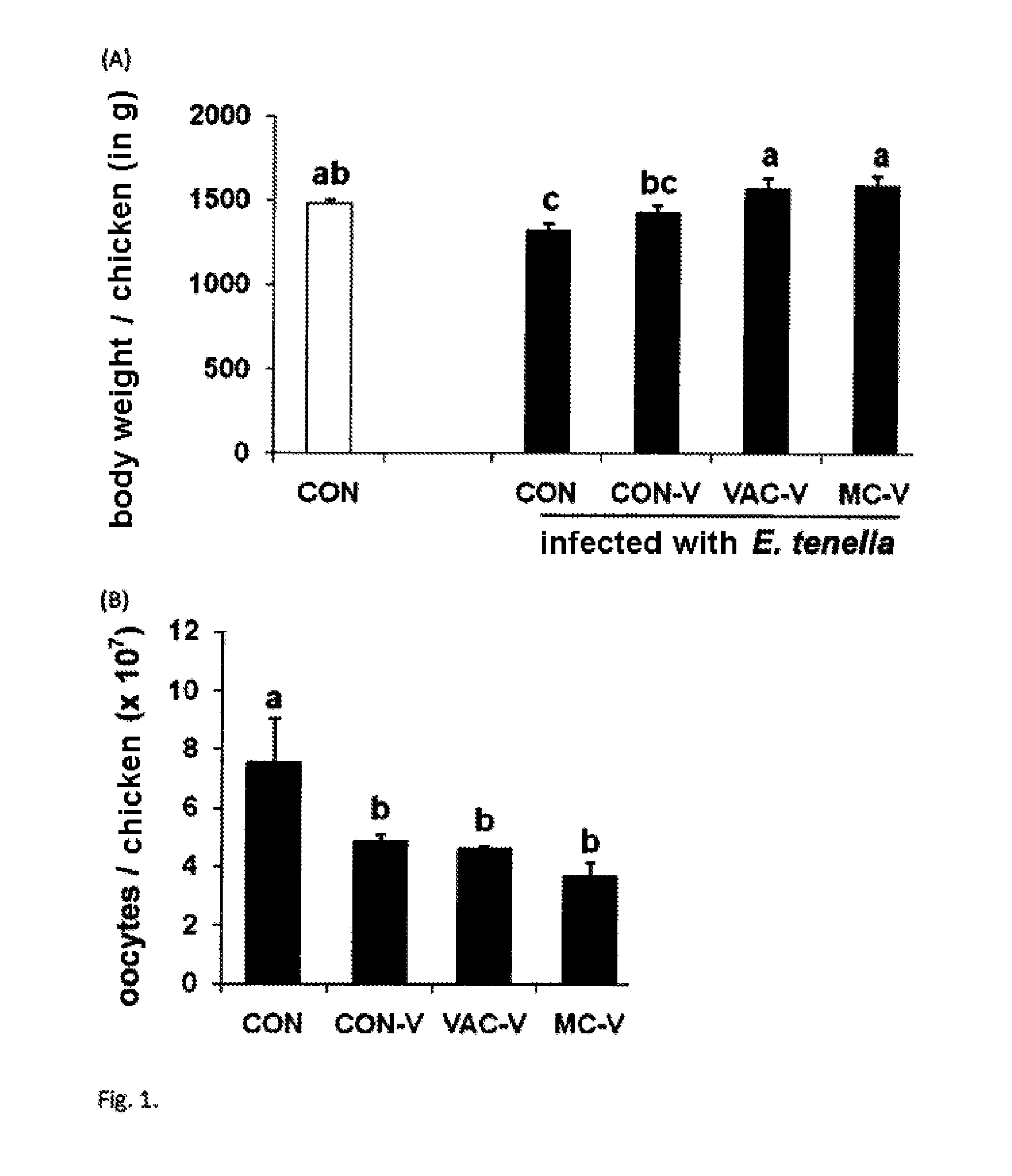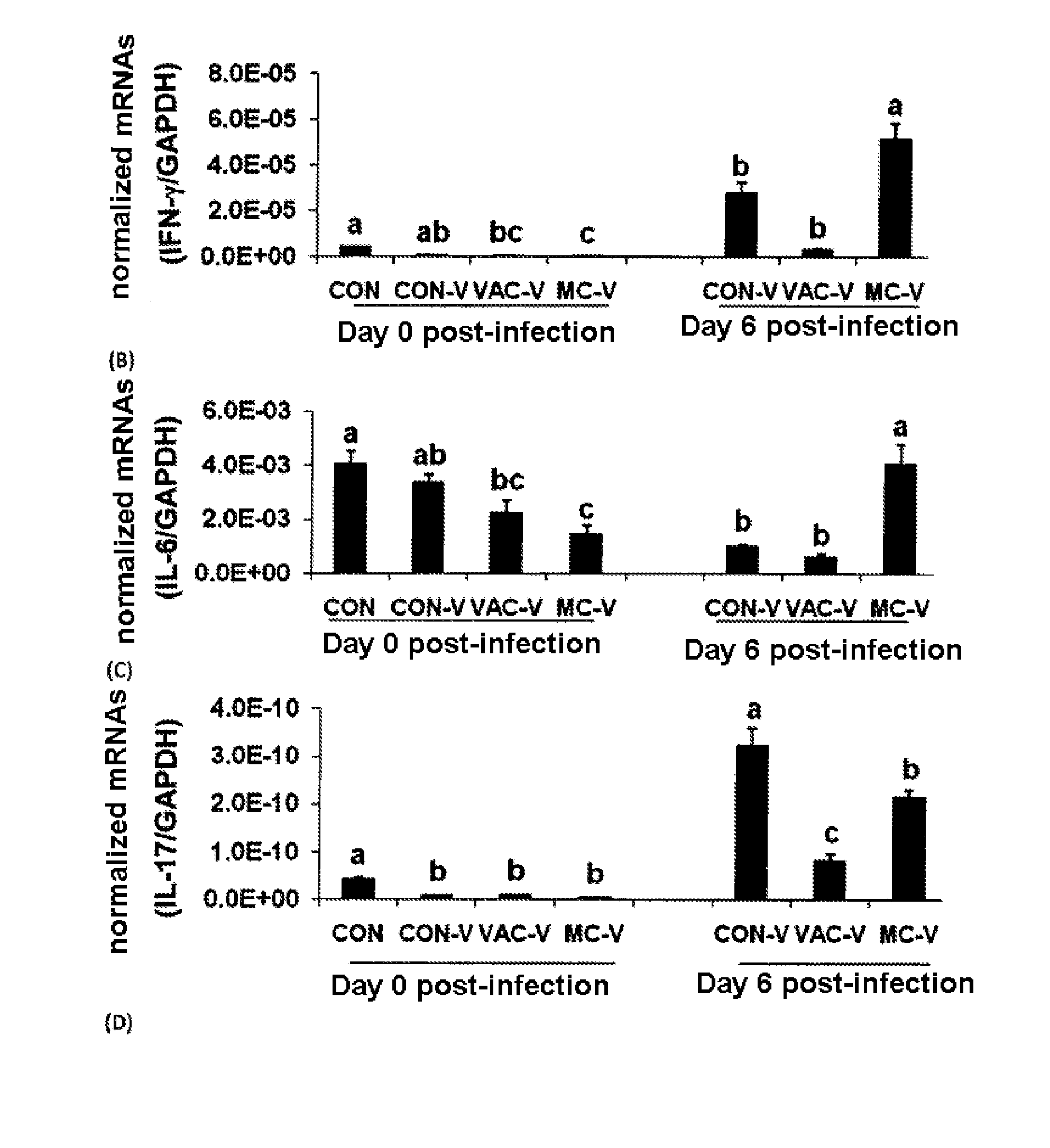Use of a food additive based on at least one phytonutrient for stimulating vaccine immunity against apicomplexa in animals
- Summary
- Abstract
- Description
- Claims
- Application Information
AI Technical Summary
Benefits of technology
Problems solved by technology
Method used
Image
Examples
example 1
Effect of VAC and MC Supplementation on Body Weight
[0071]Method
[0072]Body weight was measured on day 0 and 9 post-infection (DPI). In order to assay the excreted fecal oocysts, the chickens were placed in special cages for collecting oocysts (2 chickens / cage, 12 chickens / group) and fecal samples were collected from day 5 to day 9 post-infection.
[0073]Results
[0074]The feeding of the farmed chickens with an intake supplemented with VAC and with MC exhibited no toxic effect in the host according to the body weight modifications and other physical characteristics at the doses used during this trial. During the first 17 days after hatching, the chickens which had received the supplemented intakes did not show any change in the level of their body weight, compared with those which had received the standard intake alone. After infection with E. tenella (day 10 post-infection), however, the chickens immunized with the vaccine against profilin (CON-V, VAC-V, MC-V) exhibited body weights whic...
example 2
Effect of VAC and MC Supplementation on Fecal Oocyst Excretion
[0075]Methods
[0076]The numbers of oocysts were determined as previously described in the literature using a MacMaster cell and according to the following formula: total oocysts / chicken=[number of oocysts×dilution factor×(volume of the fecal sample / volume of the counting cell)] / 2.
[0077]Results
[0078]As can be seen in FIG. 1B, the fecal oocyst excretion was significantly reduced by 31 to 51% in the groups immunized against profilin and supplemented with phytonutrients. The total excreted oocysts were 4.9×107, 4.6×107 and 3.7×107 / chicken, respectively in the CON-V, VAC-V and MC-V groups compared with the CON standard intake group which produced 9.5×107 oocysts / chicken. No oocyst was detected in the noninfected control chickens. These results showed that the supplementation of phytonutrients in young chickens stimulates the host's protective vaccine immune response against Eimeria tenella.
example 3
Effect of the VAC and MC Supplementation on the Antibody Responses to Profilin
[0079]Methods
[0080]Blood samples (4 chickens / group) were collected by cardiac puncture immediately after euthanasia on day 10 post-infection, and the sera were obtained by centrifugation and were analyzed by ELISA in order to measure the specific antibody responses to profilin as previously described in the literature. Succinctly, 96-well microtitration plates were coated overnight with 1.0 μg / well of a purified recombinant profilin. The plates were rinsed with phosphate buffered saline containing 0.05% of Tween® (PBS-T) and blocked with PBS containing 1% of BSA. The diluted sera (1:50) were added (100 μl / well), incubated with shaking for 2 hours at ambient temperature and rinsed with PBS-T. The bound antibodies were detected using peroxidase-conjugated rabbit anti-chicken IgGs and the 3,3′,5,5′-tetramethyl-benzidine substrate (Sigma®, St Louis, Mo.). The optical density (OD) was measured at 450 nm (OD 450...
PUM
| Property | Measurement | Unit |
|---|---|---|
| Concentration | aaaaa | aaaaa |
| Concentration | aaaaa | aaaaa |
| Dimensionless property | aaaaa | aaaaa |
Abstract
Description
Claims
Application Information
 Login to View More
Login to View More - R&D
- Intellectual Property
- Life Sciences
- Materials
- Tech Scout
- Unparalleled Data Quality
- Higher Quality Content
- 60% Fewer Hallucinations
Browse by: Latest US Patents, China's latest patents, Technical Efficacy Thesaurus, Application Domain, Technology Topic, Popular Technical Reports.
© 2025 PatSnap. All rights reserved.Legal|Privacy policy|Modern Slavery Act Transparency Statement|Sitemap|About US| Contact US: help@patsnap.com



